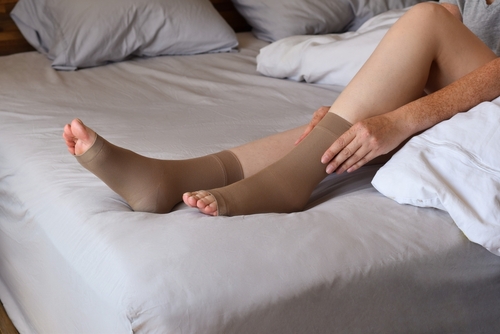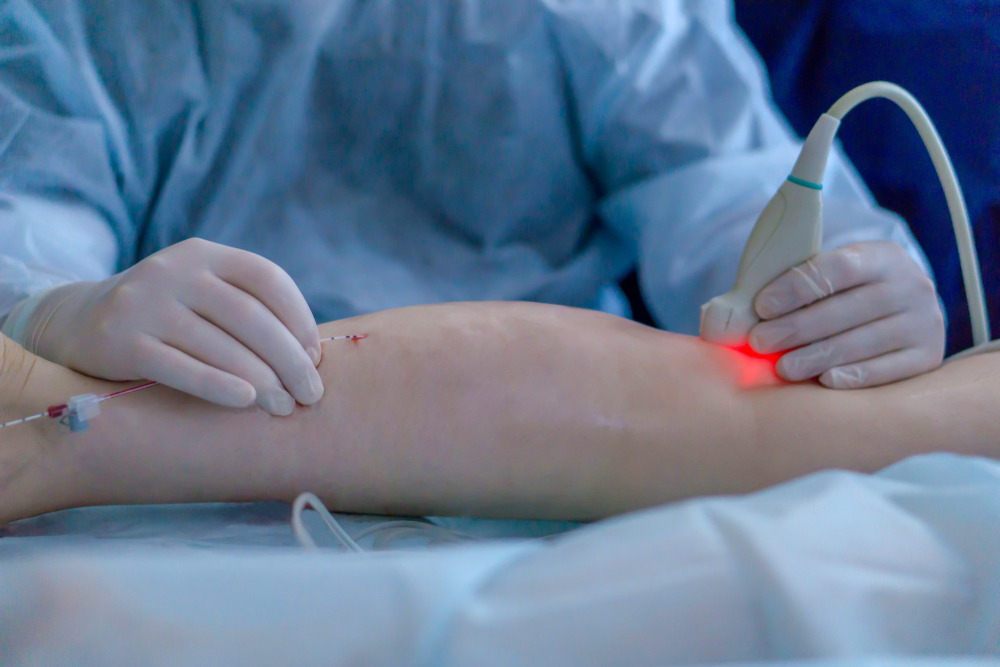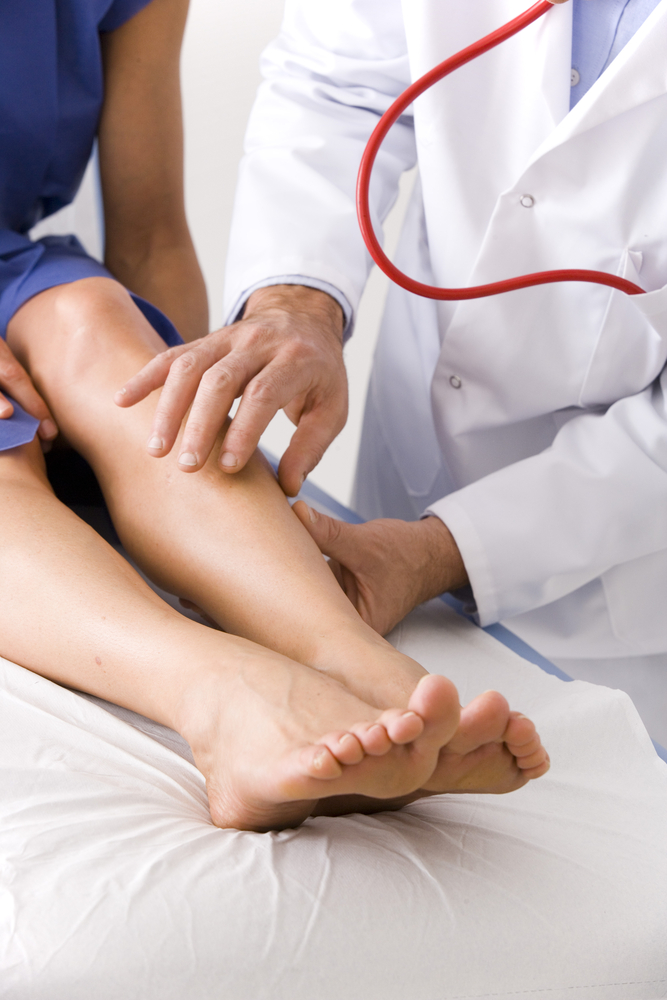
What is a Venous Skin Ulcer?
A venous leg ulcer is an open sore that develops in areas of the body where blood flow has been blocked or reversed due to poor vein function from venous insufficiency. Typically, these ulcers occur on the legs, where the blood is most prone to pooling.
What Causes Leg Ulcers?
Venous leg ulcers, or venous stasis ulcers, are painful open wounds on the leg or ankle that do not heal for weeks or months. Venous insufficiency is the leading cause of venous leg ulcers.
With venous insufficiency, unhealthy or damaged veins lead to poor blood circulation and cause blood to pool. If veins cannot effectively push blood back up to the heart, excess blood pools and can build up pressure. The increased pressure and fluid build-up blocks essential oxygen and nutrients from reaching body tissue. As a result, tissue becomes damaged and forms a wound. Furthermore, the lack of oxygen and nutrients slows wound healing, leading to an ulcer.
Ulcers can worsen quickly if left untreated, increasing the risk of complications and limb loss. Common risk factors for venous ulcers include blood clots, diabetes, obesity, aging, and injury.
Risk Factors For Leg Ulcers
Gender
Women go through changes in hormone levels throughout their lives. These changes can strain and weaken the vein walls. Women who have had multiple births are particularly at high risk because of hormonal changes.
Age
Those over 55 have a higher risk of developing blood clots. This higher risk is because our activity level decreases as we age, affecting our blood flow. Furthermore, collagen in our bodies breaks down with age, and vein walls are mostly made of collagen.
Obesity
In addition to an increased risk of stasis (stagnation of blood), obesity adds pressure to the legs and compresses the veins in the lower body. The strain damages blood vessel valves and reduces blood flow.
Immobility or Inactivity
Long periods of standing or sitting increase your risk because the lack of muscle contractions inhibits proper blood flow. The lack of blood flow increases the risk of venous disease and ulcers.
Poor Diet
Foods that are poor for heart health can also increase the risk of venous disease and skin discoloration. For example, a diet high in excess salt, refined sugars, and unhealthy trans fats can cause inflammation and affect blood flow.
Smoking
Smoking tobacco lowers oxygen levels because of the inhalation of carbon monoxide. Lower oxygen levels inflame and damage blood vessel walls, affecting blood flow and increasing the risk of venous diseases.
Existing Health Conditions
Certain health conditions can lead to leg ulcers. Those who have chronic venous insufficiency (CVI), deep vein thrombosis (DVT), blood clots, high blood pressure, existing heart conditions, kidney failure, or previous surgeries or traumatic injuries in the affected area have a higher risk of developing ulcers.

Leg Ulcer Treatment Options
You can access many blood vessel and vein diagnosis and treatment options at VeinSolutions Flint in Michigan. Learn more about the options available to you at VeinSolutions.
- At-Home Care: A few at-home treatments and lifestyle changes can help ease vascular disease symptoms by improving blood flow. To help you take care of leg ulcers, we recommend the following at-home care treatments:
- Elevating your legs to improve circulation
- Wearing prescription compression stockings to reduce blood pooling
- Avoid heavy exercise
- Wearing a compression wrap to keep blood flowing back up to your heart can also help ulcers heal more quickly. In some cases, surgery or a skin graft is needed to close up the opening in the skin.
- Clean the Wound: Properly cleaning the wound will help your ulcer heal quickly. Be sure to follow your physician’s instructions. Your physician may suggest the following:
- Wash and dry the wound thoroughly to prevent infection.
- Use antibiotic ointments on the wound if prescribed.
- Use non-adhesive dressing to cover and protect the wound. Change dressing 1 to 3 times a week.
- With medical assistance, wear a compression wrap to encourage blood flow to the heart.
- Compression Stockings: Prescription-strength compression stockings support vascular health by encouraging blood flow up the leg and into the heart. The compression prevents blood from pooling and causing the legs to swell.
- Vascular Surgery: In severe cases, a doctor may suggest removing the diseased section of the vein. The patient may be under general anesthesia.
- Radiofrequency Ablation: The doctor makes a small cut on your leg, then puts a narrow tube in your vein. The doctor uses this to inject radiofrequency energy into the vein, which heats its walls. The energy causes the vein to collapse, and the varicose veins dissolve.
- Endovenous Laser Ablation: A surgeon inserts a catheter into your vein. A laser is then threaded through the catheter and positioned at the top of the vein, which will heat the vein. This heat energy will seal it shut.
- Microphlebectomy: For the surgeon to see each vein, they need to make an incision to thread a light through. Then, the surgeon cuts the target veins and removes them through the incision with a suction device.
- Medication: A doctor may prescribe medicines that increase blood flow, like anticoagulants (blood thinners) and thrombolytics (dissolve blood clots). Medication may be in addition to compression therapy. If there is an infection in the ulcer, antibiotics may be prescribed to treat the infection.
How to Prevent Leg Ulcers
Those at risk for venous ulcers should take steps to prevent ulcers from forming. Daily check your feet, legs, ankles, and heels for cracks and skin discoloration, as these signs could indicate an ulcer forming.
Simple lifestyle changes can reduce the risk of venous ulcers. Consider these changes to improve blood flow and wound healing.
- Moisturize lower legs and feet well
- Wear compression stockings
- Quit smoking and tobacco consumption
- Keep blood sugar at a healthy level if you have diabetes
- Maintain healthy blood pressure and cholesterol levels
- Take blood thinners if your doctor prescribes them to prevent blood clots
- Stay active and exercise regularly
- Lose excess body weight from fat
- Eat heart-healthy foods
- Sleep 7-9 hours each night
Take control of your leg ulcer and regain your quality of life with Vein Solutions Flint! Our expert team of vascular specialists is dedicated to providing you with effective and compassionate ulcer treatment. Don’t let venous insufficiency ulcers hold you back any longer.

Schedule A Vascular Health Screening in Flint or Lapeer, MI
Get in contact with our highly specialized vascular doctors and surgeons at VeinSolutions. With multiple locations in Michigan, our team is ready to help ensure your circulatory health isn’t overlooked.
